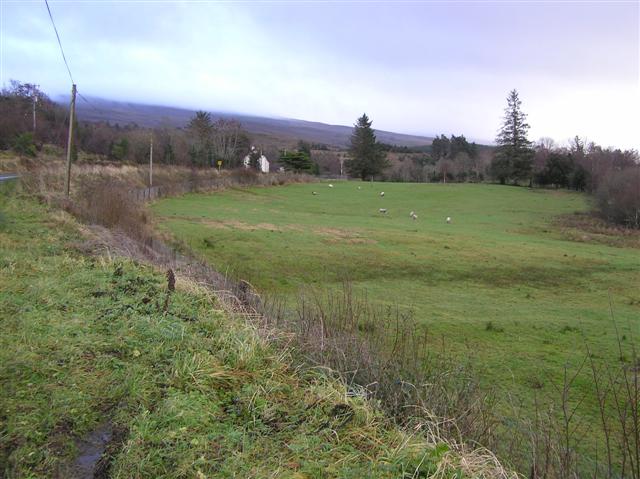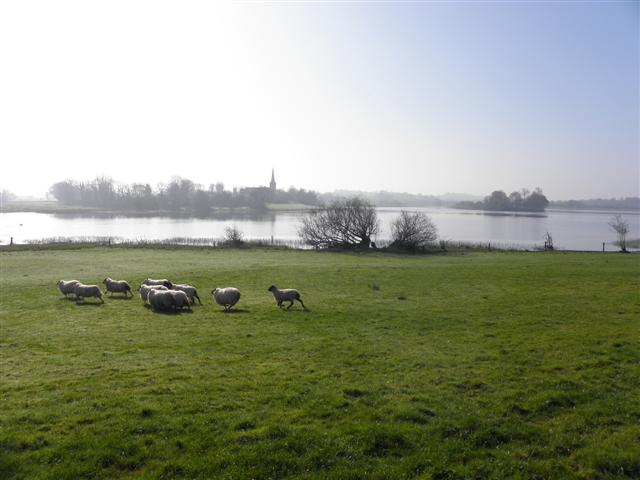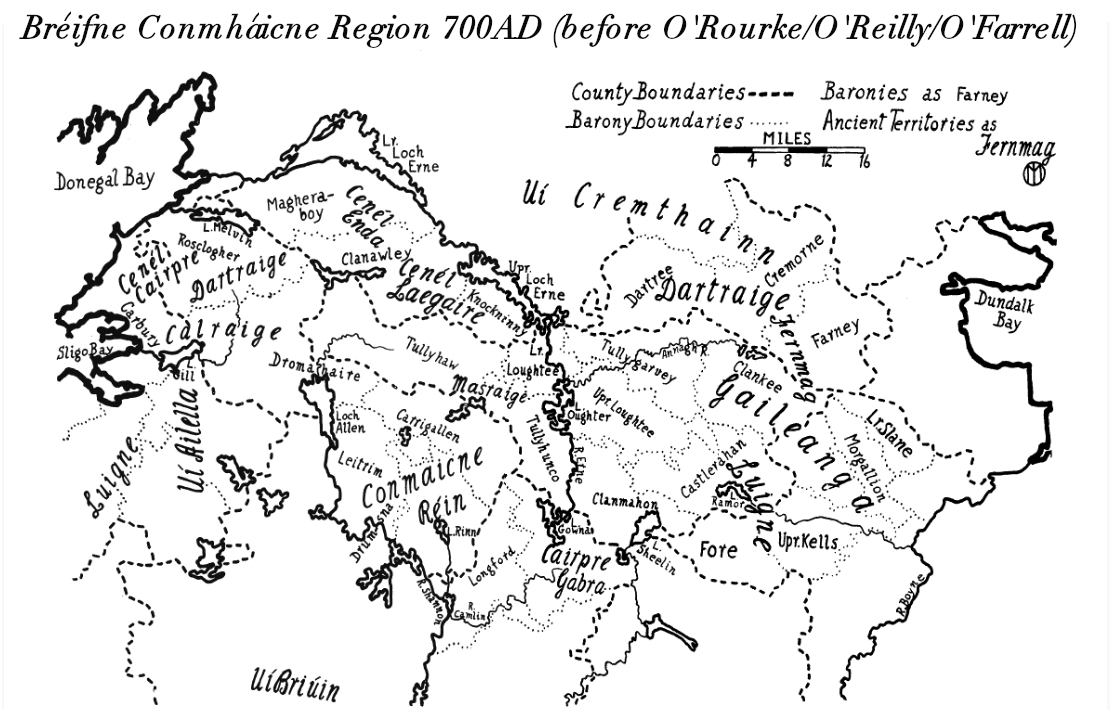|
Derrynatuan
Derrynatuan, an Anglicisation of the Gaelic, either ‘Doirín an tSuain’, meaning ''The Little Oak-wood of the Rest or Sleep'', or ‘Doire na Tóin’, meaning ''The Oak-wood of the Low Lying Land'', or ‘Doire na Tamhan’, meaning ''The Oak-wood of the Tree-Stumps'', is a townland in the civil parish of Templeport, County Cavan, Ireland. It lies in the Roman Catholic parish of Glangevlin and barony of Tullyhaw. Geography Derrynatuan is bounded on the north by Carricknagrow and Derrylahan townlands, on the west by Tullantanty and Tullynafreave townlands, on the east by Lattone townland and on the south by Drumhurrin townland. Its chief geographical features are the River Shannon, the Black River, mountain streams, a gravel pit and forestry plantations. The townland is traversed by minor public roads and rural lanes. The townland covers 185 statute acres. History John O'Donovan (scholar) in his Ordnance Survey Letters (1836, p. 16) states- ''I find it chronicled by ... [...More Info...] [...Related Items...] OR: [Wikipedia] [Google] [Baidu] |
Derrynatuan Townland (geograph 3585893)
Derrynatuan, an Anglicisation of the Gaelic, either ‘Doirín an tSuain’, meaning ''The Little Oak-wood of the Rest or Sleep'', or ‘Doire na Tóin’, meaning ''The Oak-wood of the Low Lying Land'', or ‘Doire na Tamhan’, meaning ''The Oak-wood of the Tree-Stumps'', is a townland in the civil parish of Templeport, County Cavan, Ireland. It lies in the Roman Catholic parish of Glangevlin and barony of Tullyhaw. Geography Derrynatuan is bounded on the north by Carricknagrow and Derrylahan townlands, on the west by Tullantanty and Tullynafreave townlands, on the east by Lattone townland and on the south by Drumhurrin townland. Its chief geographical features are the River Shannon, the Black River, mountain streams, a gravel pit and forestry plantations. The townland is traversed by minor public roads and rural lanes. The townland covers 185 statute acres. History John O'Donovan (scholar) in his Ordnance Survey Letters (1836, p. 16) states- ''I find it chronicled b ... [...More Info...] [...Related Items...] OR: [Wikipedia] [Google] [Baidu] |
Glangevlin
Glangevlin () is a village in the northwest of County Cavan, Ireland. It is in the townlands of Gub (Glangevlin) and Tullytiernan, at the junction of the R200 and R207 regional roads. It is surrounded by the Cuilcagh Mountains and borders the counties of Leitrim and Fermanagh. A large stone known as 'Maguire's chair' is deposited on the right hand side of the road, roughly 4 miles from Glangevlin village, so-called because it was supposedly the inauguration site of the Maguire clan in medieval times. Glangevlin has a strong traditional Irish background and Irish was spoken up until the 1930s, one of the last places in Cavan where this was commonplace. Glangevlin is also well known to have been the last place in Ireland to have a glacier lasting from the Ice age. The Cuilcagh mountains were the last affected part of the island of Ireland as well as the most western part of Europe bar Iceland. Etymology Some sources, including ''A Topographical Dictionary of Ireland'', p ... [...More Info...] [...Related Items...] OR: [Wikipedia] [Google] [Baidu] |
Derrylahan
Derrylahan, an Anglicisation of the Gaelic, ‘Doire Leathan’ meaning ''The Wide Oak-wood'', is a townland in the civil parish of Templeport, County Cavan, Ireland. It lies in the Roman Catholic parish of Glangevlin and barony of Tullyhaw. Geography Derrylahan is bounded on the north by Cornahaw townland, on the west by Carricknagrow, Derrynatuan and Lattone townlands and on the east by Corratawy, Edenmore and Gowlan townlands. Its chief geographical features are Carricknahurroo Lough, Derrylahan Lough, Lattone Lough, the source of the River Shannon in the Shannon Pot, The Black River, mountain streams, water sinkholes, a waterfall, forestry plantations, dug wells and spring wells. The townland is traversed by the regional R206 road (Ireland), minor public roads and rural lanes. The townland covers 911 statute acres. History An early reference is in the Book of Magauran. Poem X, stanza 2, composed c. 1349 by Giolla na Naomh Ó hUiginn, which states, (In it is the well whenc ... [...More Info...] [...Related Items...] OR: [Wikipedia] [Google] [Baidu] |
Lattone
Lattone, an Anglicisation of the Gaelic, ‘Leath Tóin’ meaning ''The Half-Side of a Hollow, i.e. ‘A Hillside’'' is a townland in the civil parish of Templeport, County Cavan, Ireland. It lies in the Roman Catholic parish of Glangevlin and barony of Tullyhaw. Geography Lattone is bounded on the north by Derrylahan townland, on the south by Drumhurrin townland, on the west by Derrynatuan townland and on the east by Corratawy townland. Its chief geographical features are Lattone Lough, the River Shannon, mountain streams and dug wells. The townland is traversed by the regional R206 road (Ireland), minor public roads and rural lanes. The townland covers 98 statute acres. History In 1720 Morley Saunders Morley Saunders (1671-1737) was an Irish politician, barrister and landowner. He followed in his father's footsteps by becoming a member of the Irish House of Commons and Prime Serjeant-at-law. He is mainly remembered today as the builder of Sau ... was in possession. H ... [...More Info...] [...Related Items...] OR: [Wikipedia] [Google] [Baidu] |
Drumhurrin
Drumhurrin, an Anglicisation of the Gaelic ‘Droim Shoirn’, meaning ''The Hill-Ridge of the Lime-Kiln or Furnace'', is a townland in the civil parish of Templeport, County Cavan, Ireland. It lies in the Roman Catholic parish of Glangevlin and barony of Tullyhaw. Geography Drumhurrin is bounded on the north by Lattone townland, on the west by Derrynatuan, Gowlat and Tullantanty townlands and on the east by Corratawy, Creea and Curraghvah townlands. Its chief geographical features are Drumhurrin Lough, the River Shannon, the Owenmore River (County Cavan), mountain streams, a wood, gravel pits and dug wells. The townland is traversed by the regional R206 road (Ireland), minor public roads and rural lanes. The townland covers 372 statute acres. History The 1652 Commonwealth Survey spells the name as ''Dromherne'' and gives the owner as ''Lieutenant John Blackford and others''. By 1720, Morley Saunders was the owner of the townland. By deed dated 24 December 1720 the aforesai ... [...More Info...] [...Related Items...] OR: [Wikipedia] [Google] [Baidu] |
Townland
A townland ( ga, baile fearainn; Ulster-Scots: ''toonlann'') is a small geographical division of land, historically and currently used in Ireland and in the Western Isles in Scotland, typically covering . The townland system is of Gaelic origin, pre-dating the Norman invasion, and most have names of Irish origin. However, some townland names and boundaries come from Norman manors, plantation divisions, or later creations of the Ordnance Survey.Connolly, S. J., ''The Oxford Companion to Irish History, page 577. Oxford University Press, 2002. ''Maxwell, Ian, ''How to Trace Your Irish Ancestors'', page 16. howtobooks, 2009. The total number of inhabited townlands in Ireland was 60,679 in 1911. The total number recognised by the Irish Place Names database as of 2014 was 61,098, including uninhabited townlands, mainly small islands. Background In Ireland a townland is generally the smallest administrative division of land, though a few large townlands are further divided into h ... [...More Info...] [...Related Items...] OR: [Wikipedia] [Google] [Baidu] |
Civil Parishes In Ireland
Civil parishes () are units of territory in the island of Ireland that have their origins in old Gaelic territorial divisions. They were adopted by the Anglo-Norman Lordship of Ireland and then by the Elizabethan Kingdom of Ireland, and were formalised as land divisions at the time of the Plantations of Ireland. They no longer correspond to the boundaries of Roman Catholic or Church of Ireland parishes, which are generally larger. Their use as administrative units was gradually replaced by Poor_law_union#Ireland, Poor Law Divisions in the 19th century, although they were not formally abolished. Today they are still sometimes used for legal purposes, such as to locate property in deeds of property registered between 1833 and 1946. Origins The Irish parish was based on the Gaelic territorial unit called a ''túath'' or ''Trícha cét''. Following the Norman invasion of Ireland, the Anglo-Normans, Anglo-Norman barons retained the ''tuath'', later renamed a parish or manor, as a un ... [...More Info...] [...Related Items...] OR: [Wikipedia] [Google] [Baidu] |
Templeport
Templeport () is a civil parish in the barony of Tullyhaw, County Cavan, Ireland. The chief towns in the parish are Bawnboy and Ballymagauran. The large Roman Catholic parish of Templeport containing 42,172 statute acres was split up in the 18th & 19th centuries into three new parishes, Templeport, Corlough and Glangevlin. Etymology The name of Templeport parish derives from the old townland of Templeport (which is now shortened to Port) which is the anglicisation of the Gaelic 'Teampall An Phoirt' ("The Church of the Port or Bank or Landing-Place"). The church referred to is the old church on St. Mogue's Island in the middle of Port Lake. This church fell into disuse in medieval times and a new church was built on the opposite shore of the lake. It was forfeited to Queen Elizabeth in 1590 and started use as a Protestant church in about 1610. It is very unlikely that the island church ever served as the parish church because there was only one boat available and it would have ... [...More Info...] [...Related Items...] OR: [Wikipedia] [Google] [Baidu] |
County Cavan
County Cavan ( ; gle, Contae an Chabháin) is a Counties of Ireland, county in Republic of Ireland, Ireland. It is in the Provinces of Ireland, province of Ulster and is part of the Border Region. It is named after the town of Cavan and is based on the historic Gaelic Ireland, Gaelic territory of East Breifne, East Breffny (''Bréifne''). Cavan County Council is the Local government in the Republic of Ireland, local authority for the county, which had a population of 76,176 at the 2016 census. Geography Cavan borders six counties: County Leitrim, Leitrim to the west, County Fermanagh, Fermanagh and County Monaghan, Monaghan to the north, County Meath, Meath to the south-east, County Longford, Longford to the south-west and County Westmeath, Westmeath to the south. Cavan shares a border with County Fermanagh in Northern Ireland. Cavan is the 19th largest of the 32 counties in area and the 25th largest by population. The county is part of the Northern and Western Region, a Nom ... [...More Info...] [...Related Items...] OR: [Wikipedia] [Google] [Baidu] |
Republic Of Ireland
Ireland ( ga, Éire ), also known as the Republic of Ireland (), is a country in north-western Europe consisting of 26 of the 32 counties of the island of Ireland. The capital and largest city is Dublin, on the eastern side of the island. Around 2.1 million of the country's population of 5.13 million people resides in the Greater Dublin Area. The sovereign state shares its only land border with Northern Ireland, which is part of the United Kingdom. It is otherwise surrounded by the Atlantic Ocean, with the Celtic Sea to the south, St George's Channel to the south-east, and the Irish Sea to the east. It is a unitary, parliamentary republic. The legislature, the , consists of a lower house, ; an upper house, ; and an elected President () who serves as the largely ceremonial head of state, but with some important powers and duties. The head of government is the (Prime Minister, literally 'Chief', a title not used in English), who is elected by the Dáil and appointed by ... [...More Info...] [...Related Items...] OR: [Wikipedia] [Google] [Baidu] |
Tullyhaw
Tullyhaw ( ga, Teallach Eathach) (which means 'The Territory of Eochaidh', an ancestor of the McGoverns, who lived ) is a Barony in County Cavan in the Republic of Ireland. The area has been in constant occupation since pre-4000 BC. Located in the northwest of the county, it has been referred to as Cavan's panhandle. In 1579, East Breifne, then part of Connacht, was made a shire. The shire was named County Cavan ( ga, An Cabhán) after Cavan, the area's main town. The administration remained in the control of the local Irish dynasty and subject to the Brehon and Canon Law. In 1584, Sir John Perrot formed the shire into a county in Ulster. It was subdivided into seven baronies: *two of which were assigned to Sir John O'Reilly and *three to other members of the family; *two remaining, possessed by the septs of ** McKiernan Clan and **McGovern (a.k.a. ''Magauran'') The last one, Tullyhaw, encompassed the mountains bordering on O'Rourke's country, and was left subject t ... [...More Info...] [...Related Items...] OR: [Wikipedia] [Google] [Baidu] |
River Shannon
The River Shannon ( ga, Abhainn na Sionainne, ', '), at in length, is the longest river in the British Isles. It drains the Shannon River Basin, which has an area of , – approximately one fifth of the area of the island of Ireland. The Shannon divides the west of Ireland (principally the province of Connacht) from the east and south (Leinster and most of Munster). (County Clare, being west of the Shannon but part of the province of Munster, is the major exception.) The river represents a major physical barrier between east and west, with fewer than thirty-five crossing points between Limerick city in the south and the village of Dowra in the north. The river takes its name after ''Sionna'', a Celtic goddess. Known as an important waterway since antiquity, the Shannon first appeared in maps by the Graeco-Egyptian geographer Ptolemy ( 100 – 170 AD). The river flows generally southwards from the Shannon Pot in County Cavan before turning west and emptying into the A ... [...More Info...] [...Related Items...] OR: [Wikipedia] [Google] [Baidu] |
.jpg)







.jpg)